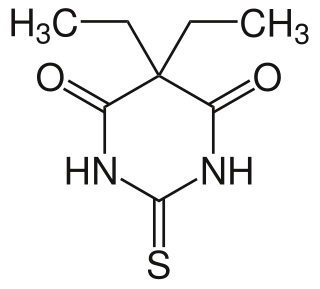
Hypnotic, or soporific drugs, commonly known as sleeping pills, are a class of psychoactive drugs whose primary function is to induce sleep and to treat insomnia (sleeplessness).

Amobarbital is a drug that is a barbiturate derivative. It has sedative-hypnotic properties. It is a white crystalline powder with no odor and a slightly bitter taste. It was first synthesized in Germany in 1923. It is considered a short to intermediate acting barbiturate. If amobarbital is taken for extended periods of time, physiological and psychological dependence can develop. Amobarbital withdrawal mimics delirium tremens and may be life-threatening. Amobarbital was manufactured by Eli Lilly and Company in the US under the brand name Amytal in bright blue bullet shaped capsules or pink tablets containing 50, 100, or 200 milligrams of the drug. The drug was also manufactured generically. Amobarbital was widely misused, known as "Blue Heavens" on the street. Amytal, as well as Tuinal, a combination drug containing equal quantities of secobarbital and amobarbital, were both manufactured by Eli Lilly until the late-1990s. However, as the popularity of benzodiazepines increased, prescriptions for these medications became increasingly rare beginning in the mid to late-1980s.

Butabarbital is a prescription barbiturate sleep aid and anxiety medication. Butabarbital has a particularly fast onset of effects and short duration of action compared to other barbiturates, which makes it useful for certain applications such as treating severe insomnia, relieving general anxiety and relieving anxiety before surgical procedures; however it is also relatively dangerous particularly when combined with alcohol, and so is now rarely used, although it is still prescribed in some Eastern European and South American countries. Its intermediate duration of action gives butabarbital an abuse potential slightly lower than secobarbital. Butabarbital can be hydrolyzed to valnoctamide.

Methohexital or methohexitone is a drug which is a barbiturate derivative. It is classified as short-acting, and has a rapid onset of action. It is similar in its effects to sodium thiopental, a drug with which it competed in the market for anesthetics.

Thiobarbital is a drug which is a barbiturate derivative. It is the thiobarbiturate analogue of barbital.

Hexobarbital or hexobarbitone, sold both in acid and sodium salt forms as Citopan, Evipan, and Tobinal, is a barbiturate derivative having hypnotic and sedative effects. It was used in the 1940s and 1950s as an agent for inducing anesthesia for surgery, as well as a rapid-acting, short-lasting hypnotic for general use, and has a relatively fast onset of effects and short duration of action. Modern barbiturates have largely supplanted the use of hexobarbital as an anesthetic, as they allow for better control of the depth of anesthesia. Hexobarbital is still used in some scientific research.

Allobarbital, also known as allobarbitone and branded as Dial, Cibalgine, or Dial-Ciba, is a barbiturate derivative invented in 1912 by Ernst Preiswerk and Ernst Grether working for CIBA. It was used primarily as an anticonvulsant although it has now largely been replaced by newer drugs with improved safety profiles. Other uses for allobarbital included as an adjutant to boost the activity of analgesic drugs, and use in the treatment of insomnia and anxiety.

Aprobarbital, sold as Oramon, Somnifaine, and Allonal, is a barbiturate derivative invented in the 1920s by Ernst Preiswerk. It has sedative, hypnotic and anticonvulsant properties, and was used primarily for the treatment of insomnia. Aprobarbital was never as widely used as more common barbiturate derivatives such as phenobarbital and is now rarely prescribed as it has been replaced by newer drugs with a better safety margin.

Butallylonal is a barbiturate derivative invented in the 1920s. It has sedative properties, and was used primarily as an anaesthetic in veterinary medicine. Butallylonal is considered similar in effects to pentobarbital but is longer in action, being considered an intermediate-acting barbiturate rather than short-acting.

Hexethal (Ortal) is a barbiturate derivative invented in the 1940s. It has sedative, anxiolytic, muscle relaxant, and anticonvulsant properties, and was used primarily as an anaesthetic in veterinary medicine.
Thiamylal (Surital) is a barbiturate derivative invented in the 1950s. It has sedative, anticonvulsant, and hypnotic effects, and is used as a strong but short acting sedative. Thiamylal is still in current use, primarily for induction in surgical anaesthesia or as an anticonvulsant to counteract side effects from other anaesthetics. It is the thiobarbiturate analogue of secobarbital.

Narcobarbital (Pronarcon) is a barbiturate derivative developed in 1932 by Carl Heinrich Friedrich Boedecker and Heinrich Gruber Schoneberg, assignors to the firm J. D. Riedel-E. de Haën AG, Berlin, Germany. Later, in 1937, may, was patented in United States. It is an N-methylated derivative of propallylonal and has similar sedative effects. It is still used in veterinary medicine for inducing surgical anaesthesia.

Thiobutabarbital is a short-acting barbiturate derivative invented in the 1950s. It has sedative, anticonvulsant and hypnotic effects, and is still used in veterinary medicine for induction in surgical anaesthesia.

Crotylbarbital, also known as crotarbital, is a barbiturate derivative developed by Eli Lilly in the 1930s. It has sedative and hypnotic effects, and was used for the treatment of insomnia until it was replaced by newer alternative drugs with fewer side effects and lower risk of overdose.

Sigmodal (Rectidon) is a barbiturate derivative. It has sedative, hypnotic and anticonvulsant properties, and was used in surgical anaesthesia in the 1950s, and frequently appeared in drug mixtures in the 60s.

Benzylbutylbarbiturate is a rare example of a barbiturate designer drug, possibly the only such compound encountered in recent years.

Barbiturates are a class of depressant drugs that are chemically derived from barbituric acid. They are effective when used medically as anxiolytics, hypnotics, and anticonvulsants, but have physical and psychological addiction potential as well as overdose potential among other possible adverse effects. They have been used recreationally for their anti-anxiety and sedative effects, and are thus controlled in most countries due to the risks associated with such use.

Cartazolate (SQ-65,396) is a drug of the pyrazolopyridine class. It acts as a GABAA receptor positive allosteric modulator at the barbiturate binding site of the complex and has anxiolytic effects in animals. It is also known to act as an adenosine antagonist at the A1 and A2 subtypes and as a phosphodiesterase inhibitor. Cartazolate was tested in human clinical trials and was found to be efficacious for anxiety but was never marketed. It was developed by a team at E.R. Squibb and Sons in the 1970s.

Methitural, or methitural sodium, also known as methioturiate, is a barbiturate derivative which was marketed in the 1950s in Europe as an ultra-short-acting intravenous anesthetic.

In pharmacology, GABAA receptor positive allosteric modulators, also known as GABAkines or GABAA receptor potentiators, are positive allosteric modulator (PAM) molecules that increase the activity of the GABAA receptor protein in the vertebrate central nervous system.



















